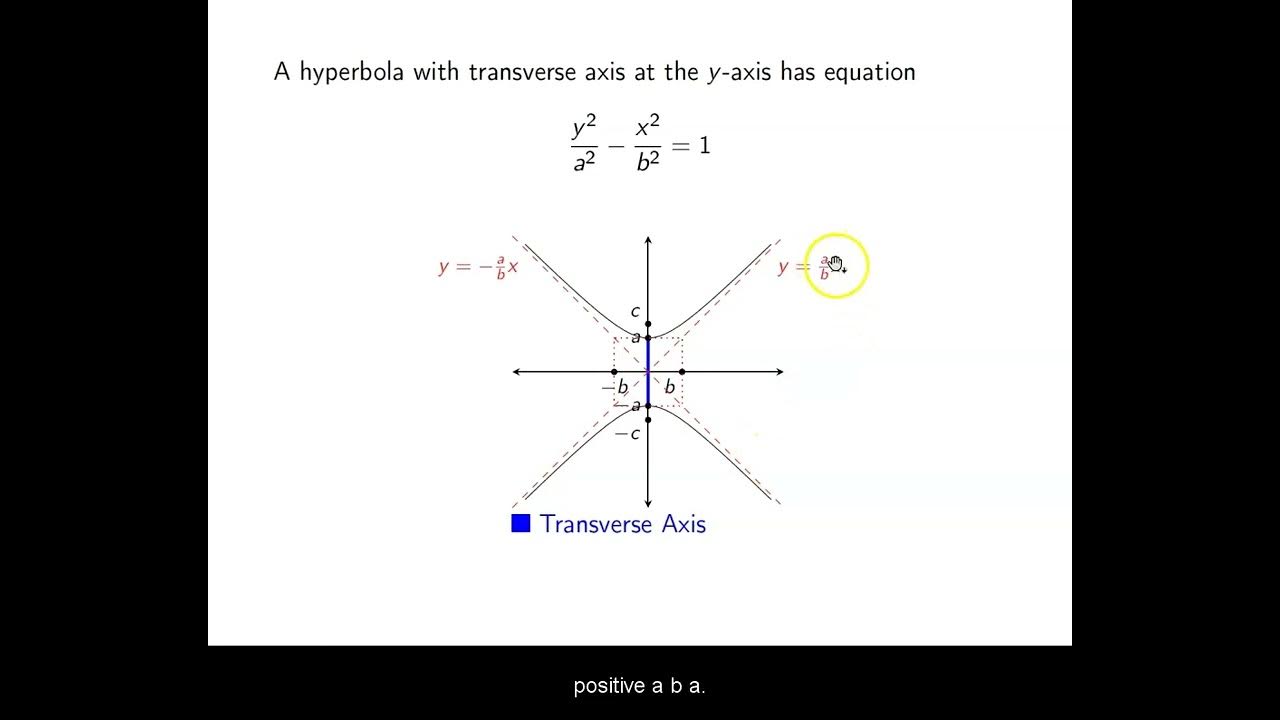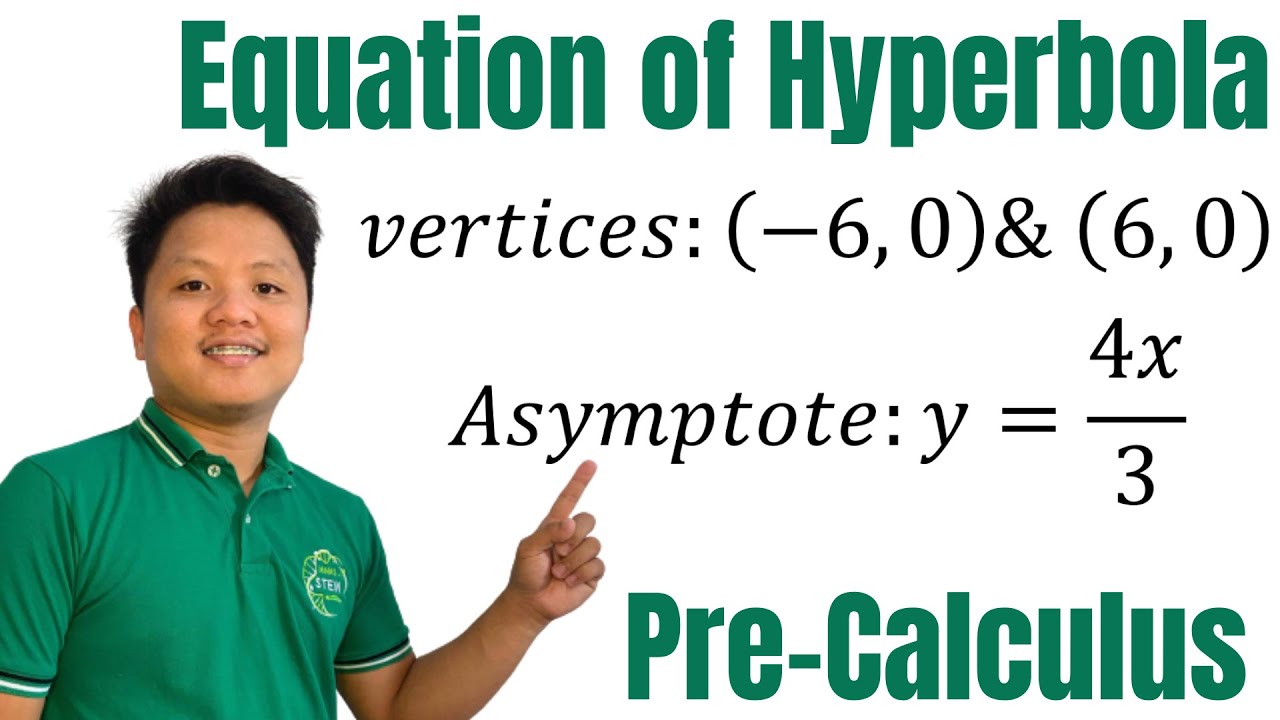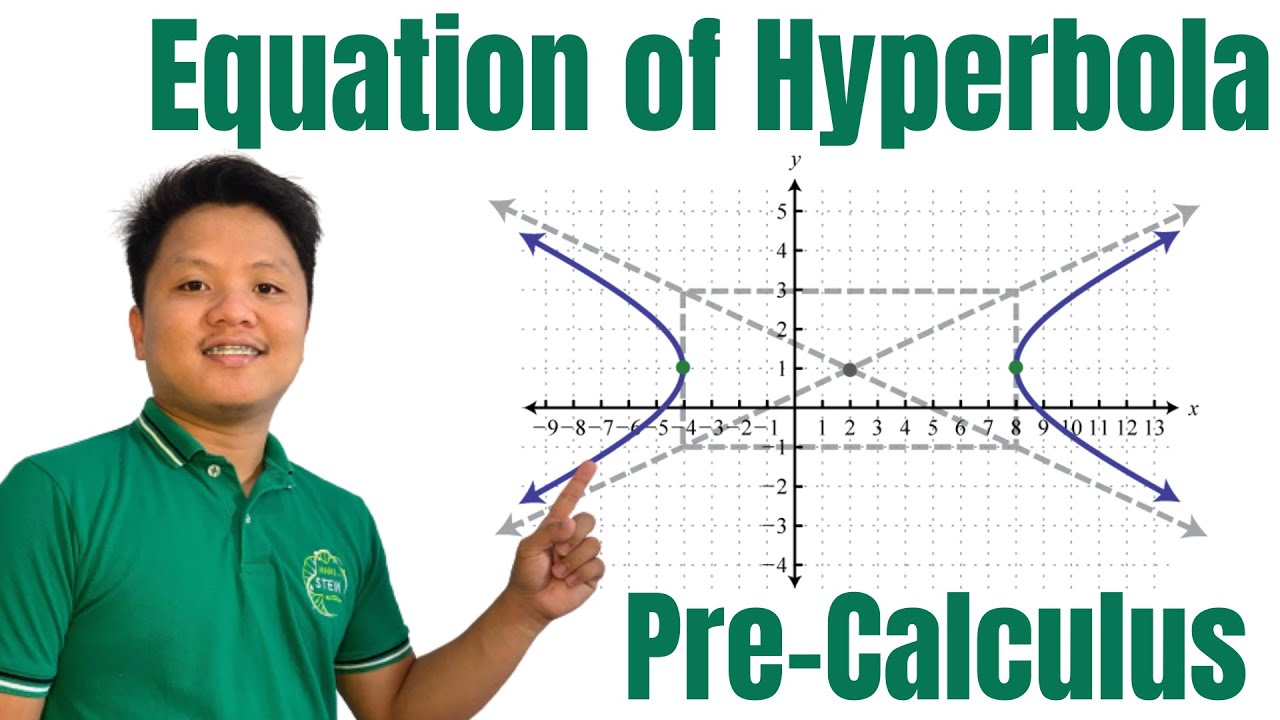INTRODUCTION OF HYPERBOLA || PRE-CALCULUS 2
TLDRThis educational video introduces the concept of a hyperbola, focusing on its standard form equations and geometric properties. It explains the difference between horizontal and vertical hyperbolas, and how to derive the equations from the center, vertices, and foci. The video also covers the asymptotes and the fundamental rectangle associated with hyperbolas, providing insights into their structure and characteristics. It aims to help viewers understand the mathematical principles behind hyperbolas and their applications.
Takeaways
- 📚 The lesson introduces the concept and standard form of the equation of a hyperbola.
- 📐 The standard equation for a hyperbola with a horizontal transverse axis is \( \frac{x^2}{a^2} - \frac{y^2}{b^2} = 1 \).
- 📏 For a hyperbola with a vertical transverse axis, the standard equation is \( \frac{y^2}{a^2} - \frac{x^2}{b^2} = 1 \).
- 📍 The center of a hyperbola is determined by constants and two fixed points known as the foci.
- 🔍 In a hyperbola, the difference between the distances from any point on the hyperbola to the foci is constant, unlike an ellipse where the sum is constant.
- 🌐 Hyperbolas have two branches that can open to the right, left, up, or down, depending on the orientation of the transverse axis.
- 📈 Each branch of a hyperbola has a vertex, and the center is the midpoint of the line segment joining the vertices.
- 🧭 The distance from the center to a focus, denoted by \( c \), can be found using the relationship \( c = \sqrt{a^2 + b^2} \).
- 📐 The conjugate axis of a hyperbola is perpendicular to the transverse axis and its length is \( \sqrt{a^2 + b^2} \).
- 📊 The fundamental rectangle of a hyperbola is defined by the vertices and asymptotes, which are the diagonals of the rectangle.
- 📝 The equations of the asymptotes for a hyperbola are \( y = \frac{b}{a}x \) and \( y = -\frac{b}{a}x \), indicating their slopes.
Q & A
What is a hyperbola?
-A hyperbola is a type of conic section that is defined as the set of all points in a plane where the difference of the distances to two fixed points, called foci, is constant.
What is the standard form of the equation of a hyperbola with a horizontal transverse axis?
-The standard form of the equation for a hyperbola with a horizontal transverse axis is \( \frac{x^2}{a^2} - \frac{y^2}{b^2} = 1 \).
What is the standard form of the equation of a hyperbola with a vertical transverse axis?
-The standard form of the equation for a hyperbola with a vertical transverse axis is \( \frac{y^2}{a^2} - \frac{x^2}{b^2} = 1 \).
What are the coordinates of the center of a hyperbola in its standard equation?
-The center of a hyperbola in its standard equation is at the origin (0,0) when the transverse axis is aligned with the coordinate axes.
How is the standard equation of a hyperbola modified to account for a shifted center?
-The standard equation is modified by replacing 'x' with '(x-h)' and 'y' with '(y-k)', where (h,k) is the center of the hyperbola.
What is the definition of the vertices of a hyperbola?
-The vertices of a hyperbola are the points on the hyperbola that are closest to the center along the transverse axis.
What is the difference between the foci and vertices of a hyperbola?
-The foci are two fixed points such that the absolute value of the difference in distances from any point on the hyperbola to these foci is constant. The vertices are the points on the hyperbola closest to the center along the transverse axis.
How many branches does a hyperbola have?
-A hyperbola has two branches that can open either to the right/left or up/down depending on the orientation of the transverse axis.
What is the relationship between the lengths of the transverse axis and the conjugate axis of a hyperbola?
-The length of the conjugate axis is related to the transverse axis by the equation \( c = \sqrt{a^2 + b^2} \), where 'c' is the distance from the center to a focus, 'a' is the distance from the center to a vertex along the transverse axis, and 'b' is the distance from the center to a vertex along the conjugate axis.
What are the equations of the asymptotes for a hyperbola with a horizontal transverse axis?
-The equations of the asymptotes for a hyperbola with a horizontal transverse axis are \( y = \frac{b}{a}x \) and \( y = -\frac{b}{a}x \).
What is the fundamental rectangle of a hyperbola?
-The fundamental rectangle of a hyperbola is the rectangle that is inscribed within the hyperbola and has its vertices on the hyperbola. The diagonals of this rectangle are the asymptotes of the hyperbola.
Outlines
📚 Introduction to Hyperbolas and Their Equations
This paragraph introduces the concept of hyperbolas, focusing on their standard form equations. It explains the difference between a hyperbola with a horizontal transverse axis, represented by the equation \( \frac{x^2}{a^2} - \frac{y^2}{b^2} = 1 \), and one with a vertical transverse axis, represented by \( \frac{y^2}{a^2} - \frac{x^2}{b^2} = 1 \). The paragraph also discusses the centered form of the hyperbola's equation, which includes the center coordinates \((h, k)\) and how the hyperbola is defined by the difference in distances from any point on the hyperbola to the two foci, rather than the sum as in an ellipse. Additionally, it touches on the hyperbola's branches and vertices, and how they relate to the orientation of the foci.
🔍 Detailed Analysis of Hyperbola Equations
The second paragraph delves deeper into the equations of hyperbolas, providing an example of a hyperbola with a horizontal transverse axis and its vertex form. It explains how to calculate the distance from the center to the vertex and the foci using the values of \(a\) and \(b\), and introduces the concept of the conjugate axis. The paragraph also discusses the relationship between the foci and the vertices and how to determine the length of the conjugate axis using the formula \( b^2 = a^2 + c^2 \), where \(c\) is the distance from the center to a focus.
📐 Understanding Hyperbola's Geometry and Asymptotes
This paragraph discusses the geometric properties of hyperbolas, including the vertices and the fundamental rectangle, which is the rectangle that contains the vertices and is inscribed within the hyperbola. It explains how to determine the vertices of a hyperbola given its equation and introduces the concept of asymptotes, which are the lines that the hyperbola approaches but never intersects. The equations of the asymptotes for a hyperbola with a horizontal transverse axis are given as \( y = \frac{b}{a}x \) and \( y = -\frac{b}{a}x \), indicating their diagonal orientation with respect to the hyperbola's axes.
📢 Conclusion and Call to Action
The final paragraph serves as a conclusion to the video lesson on hyperbolas, encouraging viewers to like, subscribe, and hit the bell button for updates on more video tutorials. It positions the channel as a guide for learning and understanding mathematical concepts, specifically focusing on the topic of hyperbolas in this instance.
Mindmap
Keywords
💡Hyperbola
💡Standard Form Equation
💡Transverse Axis
💡Conjugate Axis
💡Vertices
💡Foci
💡Constant Difference
💡Asymptotes
💡Conjugate Axis Length
💡Fundamental Rectangle
Highlights
Introduction to hyperbolas and their standard form equations.
Standard equation of a hyperbola with a horizontal transverse axis: \( \frac{x^2}{a^2} - \frac{y^2}{b^2} = 1 \).
Standard equation of a hyperbola with a vertical transverse axis: \( \frac{y^2}{a^2} - \frac{x^2}{b^2} = 1 \).
Centering a hyperbola with its center at the origin.
Hyperbola is determined by a pair of foci and a given constant.
Difference between distances to foci is constant for a hyperbola.
Hyperbola has two branches that can open in any direction.
Each branch of a hyperbola has a vertex, and the center is the midpoint of the vertices.
Equation and properties of a hyperbola with a horizontal transverse axis.
Equation and properties of a hyperbola with a vertical transverse axis.
Calculating the distance from the center to the vertices and foci.
Conjugate axis of a hyperbola and its relationship to the transverse axis.
Fundamental rectangle of a hyperbola and its vertices.
Asymptotes of a hyperbola and their equations.
Asymptotes contain the diagonals of the fundamental rectangle.
Thanking viewers for watching and encouraging engagement with the channel.
Transcripts
Browse More Related Video

STANDARD EQUATION OF HYPERBOLA WITH CENTER AT (h, k) || PRE-CALCULUS

Graphing Conic Sections Part 4: Hyperbolas

Ch. 11.3 Hyperbolas

Find the equation of Hyperbola given vertices and asymptote

How to find the equation of Hyperbola given its graph

RECOGNIZING THE EQUATION AND THE IMPORTANT CHARACTERISTICS OF THE CONIC SECTIONS || PRECALCULUS
5.0 / 5 (0 votes)
Thanks for rating: